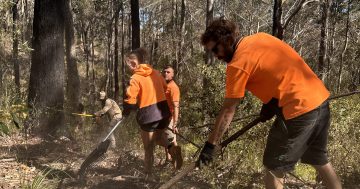
A rare, native Hibiscus richardsonii plant has been discovered on a burnt headland at Malua Bay. Photo: Supplied.
Rare, native plants are sprouting to life at Malua Bay, on the NSW South Coast. The discovery has been made at one of 14 sites across the Eurobodalla Shire being monitored to record the recovery of vegetation and the appearance of weeds.
Consultant botanist Jackie Miles said the returning vegetation was a mixture of post-disturbance colonisers, which disappear once normal vegetation returns, and plants that formerly occupied the sites.
“Many Australian plants have evolved to cope with fire, recovering by resprouting or growing from seed,” she said.
“A rare, native Hibiscus richardsonii was discovered on a burnt headland at Malua Bay, which was totally unexpected. I didn’t even know this species existed until I started to identify the specimen I brought back. It was definitely exciting.
“There have been only four records [of the plant] from the Far South Coast so it’s not common that’s for sure.”
Ms Miles also expects to see more of the fan-flower (Scaevola aemula), a post-disturbance coloniser, come spring.
“It’s found on the headlands at Rosedale and Malua Bay, and in the spring we expect to see bright purple, blue and mauve fan-flowers across the headlands,” she said.
Eurobodalla Shire Council established 14 monitoring sites in February to help understand how local vegetation recovers after a bushfire, and ultimately assist in its management. Over time, a photograph is taken from a fixed point at each site, showing the visual change to vegetation.
Ms Miles said the good news is that vegetation is bouncing back, whether the main species in an area are resprouters or seed germinators.
“The site behind Broulee Primary School is a good example of resprouters, where the main understorey was burrawangs and bracken, which bounce back really fast,” she said.
“However, the species on the headlands at Rosedale and Malua Bay are coming back from seed so it’s a little slower to respond.”
Unfortunately, weeds are also taking the opportunity to colonise the burnt ground.
“Sites that were weedy pre-fire remain weedy,” said Ms Miles. “The most common weedy species on the sites are exotic Solanum (Nightshade) species and Inkweed.
“But if people want to do some weeding they need to check before they start pulling things out. Make absolutely sure they are weeds.”









